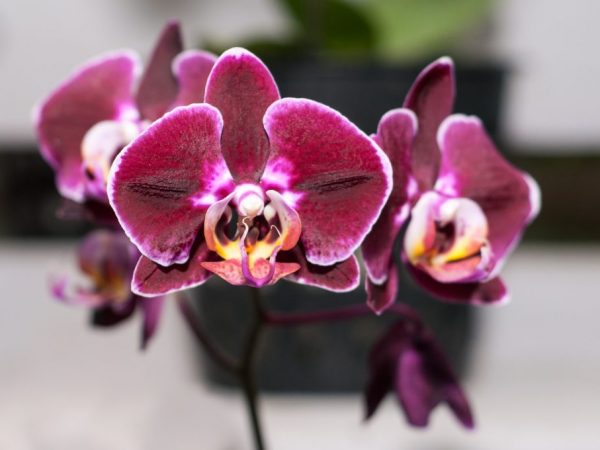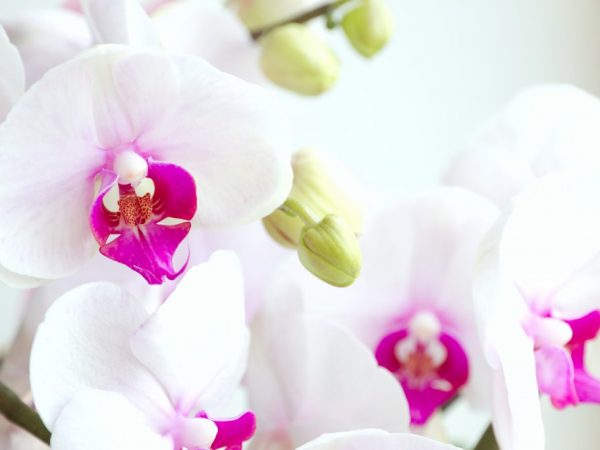Description of Phalaenopsis Big Lip Orchid
Big Lip Orchid is a flower that looks like a moth. The description of the orchid helps to understand the peculiarities of its cultivation and care.

Description of Phalaenopsis Big Lip Orchid
Orchid description
Phalaenopsis Big Lip was bred by botanists in Taiwan.
The orchid is delicate, susceptible to injury, poorly overcomes transportation. The size of the flower reaches 9-10 cm, the growth of the orchid is 70-80 cm, the number of leaves is 2-3 pairs. According to the description, the orchid has unfolded petals, the lower one is straight and with a flat surface.
As they grow older, the number of peduncles, branches and flowers on the plant grows. Big Lip grows for about 10-15 years, while it is renewed by children or division.
Flowering Big Linden begins 3 years after the separation of the baby in another pot, lasts about 2 months and is repeated twice a year.
Growing
The color options of the flower are varied: white, bright fuchsia, pink-lilac, purple, orange, with dots and veins, contrasting lip.
Varieties of Big Lip orchids:
- Leontine - white petal and pale purple pattern on the curly lip;
- Melody - streaks of crimson, burgundy color on the petals;
- Multiflora - different colors, flowers no more than 6 cm in diameter;
- Velvet with black coloring.
Landing
Planting an orchid called Big Lip is carried out according to certain rules.
Instead of soil, large bark is used for growing. The digestion process helps to get rid of pests, fungi and unnecessary essential oils. It is better to exclude impurities of coal and sphagnum moss, coconut chips, since there is an accumulation of liquid, rot develops.
A suitable container for growing a peduncle is a pot with a water drainage slot that holds the roots and allows light and air to pass through. A small benefit for a glass pot due to its weight: it will be more stable when the leaves are hanging.
During planting and cultivation, diseased roots are removed, the cuts are sprinkled with charcoal. The soil is laid to maintain the balance of the flower, the roots are placed in the pot, as in the air.
Reproduction methods
Reproduction occurs vegetatively. It is stimulated by creating a stressful situation for the plant: creating dryness or reducing the temperature to 18 ° C-20 ° C. After the leaves appear on the branch of the flower, the development of the root system is expected and the orchid is transplanted to a new place.
Care

The orchid should be in a tray of water
Phalaenopsis growing conditions:
- the scattering effect of bright lighting, temperature 22 ° C-24 ° C during the day, 18 ° C-20 ° C at night;
- calmness - it is better for the plant to be in one position, especially during the period of tying buds;
- humidity in the room - use a humidifier or put a tray with liquid;
- correct watering;
- no drafts to avoid the appearance of rusty rot spots.
Phalaenopsis needs to bloom, after which a transplant is possible, it is required in cases of detecting pieces of sphagnum, dark spots on the roots, foreign inclusions.Be sure to remove painful roots, pieces of sponge, moss from the pot.
If the roots of the orchid turn pale, it's time to water it. During watering, the plant is fed with complex mineral fertilizers, diluted with water in advance. Top dressing is carried out before or after flowering and bud setting.
Stimulating flowering
Maintaining night and day temperatures at 18 ° C-24 ° C for 2 months helps the orchid to develop and bear flower stalks.
If Big Lip does not bloom, it is stimulated with special means:
- Epin;
- succinic acid;
- cetokinic acid.
Pruning after flowering
As soon as flowering ends, the bud on the flower turns yellow, pruning above the second flower bud is allowed. It is more difficult to grow a flower stalk from a bud between leaves than a new branch.
Diseases and pests
The Big Lip Orchid is subject to disease and pests if mistakes are made in the care.
If yellowing or rot occurs, the stages of care are revised, do not forget to fertilize the orchid: this increases its immunity.
Disease and pest control
Diseases and pests are eliminated in the following ways:
- mechanical - manual collection of all pests, but it will not provide complete disposal of parasites;
- chemical - the use of insecticides at least 2 times with a frequency of 5-7 days;
- folk methods - a solution of soap.
Prophylaxis
Prevention of diseases and pests:
- regular feeding;
- protection from winds, drafts (for this they provide the optimum temperature, humidity);
- Isolation of newly arrived plants for 30 days (this helps to keep the flowers from parasites).
Conclusion
Phalaenopsis Big Lip requires responsible care. With the right approach to growing, reproducing, replanting, feeding, pruning and pest control, the plant will grow healthy and strong.

